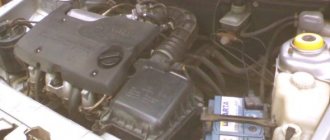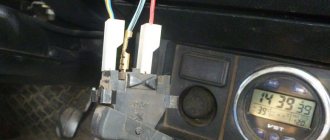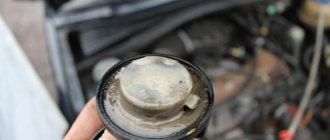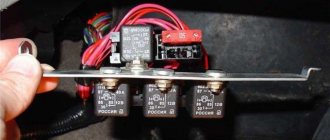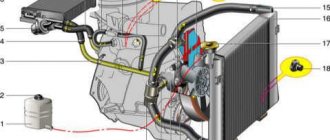Signs of air accumulation
In order to check whether air has accumulated in the heater, you need to turn on the heater and place your hand on the place where air should flow into the cabin. If it blows warmly, then there is no problem. If the air is cold and does not heat up after a maximum of 2 minutes, it means the stove is airy. There are plugs in the cooling system and they need to be removed.
Important: we check the operation of the stove only when the car is warmed up. In addition, make sure that your heater radiator is in working order.
Folk way
This method of deflation came to us from the people. That is, in a logical way, drivers came up with the idea of parking the car at an angle so that the air bubble would come out of the heating system during certain actions.
So, you need to find a hill with a slight slope. An overpass will also do. Drive the car onto it so that the front is as high as the rear as possible. The plug will go away if your engine idles for a couple of minutes. However, this method does not always help. However, this method is the cheapest and easiest, so it makes sense to try it. If it doesn’t help, read on to learn how to blow out the heater on a VAZ-2107.
Checking the hoses
The second way to expel air from the VAZ-2107 stove is to find the hoses from the cooler under the hood and move them. It is quite possible that such a mechanical effect will provoke the release of an air bubble.
- Open the car hood.
- Find the radiator outlet, bypass and supply hoses.
- Press your hand three times on each of the hoses.
After the completed manipulations, check the operation of the heater. If warm air comes out, then the problem is solved. If everything remains as it was, it’s time to try the next method of airing.
Malfunctions
Quite often, on VAZ 2106 cars, the engine cooling system fails and requires repair. The main elements that are most subject to wear are the radiator and thermostat. More rarely, the cause of failure is in the pipes. In order to determine that there is a malfunction in this particular system, it is enough to know its characteristic symptoms. The first thing that immediately becomes noticeable is engine overheating. At the same time, in the area of the legs of the passenger and driver, high temperature and hot air flows will be felt. The cause of this malfunction may be either a failure of the thermostat or radiator, or wear of the pipes.
The difference is that when cracks appear in the pipes, a leak of antifreeze or antifreeze will be visually noticeable. It will ooze out, either from cracks or from joints. When you open the hood, there will be visible places on the engine parts that differ significantly from the basic condition, especially in their shine. This effect is obtained due to the constant exposure of the coolant to the same part of the coating.
If the radiator or thermostat is broken, there may not be any drips, but in this case, the antifreeze simply does not enter the radiator, but constantly circulates in the system, not having time to cool, and as a result, boiling away.
The most common cause of antifreeze leakage from a VAZ 2106 engine is wear of the radiator cap valve. It is not possible to determine its failure immediately. If after each trip the antifreeze level decreases, then carry out the following procedure. Immediately after the engine warms up, open the hood and pull out the choke a centimeter so that the crankshaft speed reaches 2000 - 2500 rpm. Keep a close eye on the lid. If, over time, liquid begins to emerge from under it, then this is clearly the reason.
Step-by-step instruction
The next method of how to blow out the stove on a VAZ-2107 will be discussed step by step. So:
- Unscrew and pull out the top pipe. This pipe goes directly to the stove, and this is the highest point where air can accumulate.
- We insert the pipe into place without twisting it.
- Fill the antifreeze tank full. It’s better to play it safe and pour antifreeze through a cloth to prevent debris from getting into the heating system. This is a rather tedious and time-consuming process, but it is necessary so as not to damage the system.
- We start the engine and bring it to 80 degrees. Now you need to let the air out through the highest pipe.
- To do this, we take it a little and move it.
- We carry out this procedure until the antifreeze flows out. If the antifreeze has poured out, it means that almost all the air has already escaped.
- If a small air bubble remains, it will then come out through the expansion tank.
This is one of the most effective ways to blow out the stove on a VAZ-2107. With the help of these instructions you will cope with this problem and be sure to restore the operation of the stove!
Device
The first place where the fluid begins its flow is the radiator. On VAZ 2106 models, two types of radiators were installed - copper and aluminum. The first one is of higher quality, and if cracks appear on its surface, they can easily be welded. In contrast, any crack on an aluminum part is its certain death.
The radiator figuratively consists of three parts: the upper barrel, the cooling honeycomb and the lower barrel. The upper tank has a filler neck for adding coolant. During operation, hot liquid that has gone through one cycle is collected in this tank. Further, it descends into the lower barrel, through the honeycombs, simultaneously being cooled by a fan. And in the lower tank, the liquid is already completely cooled and ready for use.
Tubes are connected to the radiator from above and below: two wide and one narrow. A narrow tube connects the radiator to an expansion barrel, designed to allow excess liquid to enter it during heating and expansion. The upper wide tube connects the part to the thermostat, which, in turn, uses a valve to regulate the flow of coolant. Fluid can flow from the thermostat either back to the engine cylinder block or to the radiator.
For forced circulation, the system includes a pump that pumps antifreeze, creating pressure inside the block. Between the cylinders, a specially made void is provided, where this liquid enters.
How to remove air from the cooling system of a VAZ 2107
The panel is not seven-dimensional, but it conveys the essence.
Every car enthusiast's worst nightmare is a traffic jam in the engine air system. And it’s good if you caught its presence in time and eliminated it, but what if this stray, due to your carelessness, happened on the road and your strong engine began to boil and refused to go further? What to do? Eliminate traffic jams because there is nothing more to do.
The main thing is not to get boiled with boiling water!! and everything will be fine. Checked, no mines © Avtolyubitel
I had an old basin, model 2107. After a long period of inactivity and a planned replacement of the fluid in the cooling system, I was faced with the problem of the presence of air in the above-mentioned cooling system. And no matter how much I butted heads with her, my little girl never wanted to keep the 90° Fahrenheit allotted to her.
The arrow kept creeping up, the stove didn’t heat up, the engine began to boil and began to snort antifreeze from the pipes that had long since leaked.
But it was evening and there was no hurry. I decided to google the Internet in search of an answer to the question - damn, how can I get air out of the cooling system of a VAZ 2107?
Found!! There are as many as three ways. And he went to bed contentedly, for the morning is wiser than the evening.
After reading everything possible and impossible, systematizing information on getting rid of air in the cooling system, I came to a conclusion. There is no definite method, it seems that everything works, but you need to select it for yourself, or rather for the individual characteristics of the car, namely with or without a cap on your cooling radiator, above or below the expansion tank relative to the horizon level.
General recommendations for prevention
The first thing you need to pay attention to is the level of antifreeze in the cooling system . Always monitor it and top up if necessary. Moreover, if you have to add coolant very often, then this is the first call indicating that something is wrong with the system, and additional diagnostics are necessary to identify the cause of the malfunction. Also check for stains from antifreeze leaks. It is better to do this in the inspection hole.
Try to use the antifreeze recommended by your car manufacturer. Make purchases in trusted, licensed stores, minimizing the likelihood of purchasing a counterfeit. The fact is that low-quality coolant can gradually evaporate during repeated heating, and instead of it, an air plug forms in the system. Therefore, do not neglect the manufacturer's requirements.
Instead of a conclusion
Finally, I would like to note that if the described signs of airing in the system appear, it is necessary to carry out diagnostics and check it as quickly as possible. After all, an air lock significantly reduces the efficiency of the cooling system. Because of this, the engine operates under conditions of increased wear, which can lead to premature failure. Therefore, if you detect airing, try to get rid of the plug as quickly as possible. Fortunately, even a novice car enthusiast can do this, since the procedure is simple and does not require the use of additional tools or devices.
How to get rid of air in the cooling system?
Simply put, the network describes three main ways to get rid of air in the engine cooling system:
- Just fill it in and wait for the air to come out of the system on its own. It can take from 3 to 6 hours.
- Forcibly get rid of air by purging the system or starting the engine.
- And find the highest point in the cooling system and bleed the air.
- If the 2107 is fuel-injected, then it is recommended to raise the face on jacks.
If your seven is injector . The face must be raised on jacks so that the top dead center of the cooling system becomes the throttle assembly. From which the thin heating pipes are then disconnected and the air is bleed.
If the seven is carburetor , then there is no need to raise the muzzle. It is enough just to disconnect the heating pipe of the starting manifold, located in its rear part.
Theoretically, you can get rid of air forcibly without disconnecting any hoses. Start the engine and let it run for a while. But this method, as operating practice has shown, is not 100%.
If the impeller on the pump is damaged and, therefore, the pressure in the cooling system is lower than recommended, then the pump will not cope with moving air into the expander. Air can simply get stuck in the cooling jackets of the block and cylinder head, or in the thermostat.
We expel the air lock from the VAZ 2107 cooling system
During the operation of a VAZ 2107 car, it is necessary to carry out not only repairs of failed parts, but also preventive measures. One of these measures is replacing the coolant in the system. However, often after replacing the coolant, air pockets appear in the system. That is why the relevant question is how to remove air from the VAZ 2107 cooling system in order to prevent the engine from overheating and failing.
see also
Antifreeze in oil
Oil in antifreeze
Antifreeze reducing additives
Antifreeze is boiling
Why does antifreeze go away?
The presence of air in the cooling system is fraught with problems for both the engine and other components of the car. In particular, overheating may occur or the stove will heat poorly. Therefore, it is useful for any motorist to know how to remove an air lock from the cooling system. This procedure is quite trivial, so even a beginner and inexperienced car enthusiast can do it. Due to its importance, we will talk about three methods of removing air. But first, let's talk about how to understand that air jams are occurring and the reasons for their occurrence.
Signs of air in the cooling system
The presence of an air lock in the engine cooling system causes serious consequences, including overheating of the engine and its failure. The presence of a plug will immediately manifest itself in the form of uneven heating of the engine. The air in the system restricts the passage of coolant in a large or small circle. The fact that the plug is present helps reduce the heat exchange between the engine and the antifreeze, so there will be an increase in temperature above the maximum level, which is unacceptable.
The plug can also prevent the passage of fluid to the heater core, so driving the car in winter will be cold. Heated antifreeze does not pass to the heater radiator through the cooling system of the VAZ 2107, so when it is turned on, a stream of cold air will blow into the cabin.
It is contraindicated to operate the machine in this condition until air has been removed from the system. To remove it, several different methods are known, which are described in detail in the material.
Reasons for the formation of air pockets
The formation of a plug in the cooling system is also called airing. This phenomenon occurs in the pipes and hoses, whereby their throughput capacity is lost, thereby causing overheating of the engine and boiling of the coolant. Before you remove the plug from the system, you will need to understand the reasons for its occurrence.
It is necessary to identify the causes of airing in order to prevent its reoccurrence. So, let's look at the reasons for airing the cooling system of the VAZ 2107 injector:
- Incorrect coolant replacement. This is a common reason why a vehicle owner is faced with the problem of a traffic jam in the system. If the reason is improper replacement of the coolant, then after releasing the air from the system, the problem will be solved.
- Air jams also form due to depressurization of the system. You can detect such defects yourself by checking each pipe connection. If there are coolant leaks, the clamps or pipes should be replaced if there are signs of wear. Removing the plug is possible only after the causes have been eliminated, that is, you first need to tighten all connections or replace the pipes.
After identifying and eliminating the causes, you can begin drastic actions to eliminate air pollution on the VAZ 2107.
Stopper removal methods
To remove the plug, or rather to prevent its occurrence, you need to do the following simple steps while pouring coolant:
Reasons for airing
The air that has penetrated into the system is collected into one bubble, moving through the channels to a certain place. Having reached the highest point or narrowing, it stops and blocks the flow of antifreeze (antifreeze). Practice shows that most often an air lock occurs in a large circulation circuit, including the main radiator. Although the opposite situation also happens, for example, airing of the heat exchanger of the cabin heater (in common parlance - the stove).
How air enters the cooling system of a car engine:
- the most common case is incorrect filling with antifreeze;
- due to antifreeze leaks through loose connections or faulty parts, for example, a leaky pump seal;
- due to jamming of the bypass valve built into the expansion tank plug.
The main task solved during the process of filling antifreeze is to simultaneously expel air from the cooling system. If you perform the operation in a hurry and do not follow simple rules, the formation of an air lock is guaranteed. Quick filling allows air to enter the system along with the liquid through the funnel, and then collect into one bubble.
Important point! An obvious sign of airing is a critical rise in coolant temperature at any engine operating mode.
The inclusion of an electric fan depends on the make and model of the car: if the temperature sensor is in the cylinder head, forced airflow will definitely work. If the meter is located differently (in the main radiator, on the pipe), the fan may not start due to the sensor being in a stagnant zone.
How will air get through leaks in a pressurized system, you ask? The algorithm is simple:
- During the heating process, the antifreeze increases in volume and displaces the air layer from the expansion tank through the plug valve.
- After the engine stops, the coolant cools and compresses to its previous volume, and the valve lets the air back in.
- As the antifreeze cools and contracts, leaks in the system elements will turn into sources of additional air leaks.
Similarly, airing of the cooling system occurs due to the jamming of the bypass valve. Cooling and shrinking antifreeze provokes the formation of a vacuum, which is not replenished by air flow from the outside. Then suction occurs in the weakest connections.
